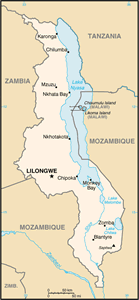The Geography of Malawi
The Geography of Malawi
Malawian Geography
Location: Southern Africa, east of Zambia
Geographic coordinates: 13 30 S, 34 00 E
Map references: Africa
Area: total: 118,480 sq km land: 94,080 sq km water: 24,400 sq km
Area - comparative: slightly smaller than Pennsylvania
Land boundaries: total: 2,881 km border countries: Mozambique 1,569 km, Tanzania 475 km, Zambia 837 km
Coastline: 0 km (landlocked)
Maritime claims: none (landlocked)
Climate: sub-tropical; rainy season (November to May); dry season (May to November)
Terrain: narrow elongated plateau with rolling plains, rounded hills, some mountains
Elevation extremes: lowest point: junction of the Shire River and international boundary with Mozambique 37 m highest point: Sapitwa (Mount Mlanje) 3,002 m
Natural resources: limestone, arable land, hydropower, unexploited deposits of uranium, coal, and bauxite
Land use: arable land: 20.68% permanent crops: 1.18% other: 78.14% (2005)
Irrigated land: 560 sq km (2003)
Natural hazards: NA
Environment - current issues: deforestation; land degradation; water pollution from agricultural runoff, sewage, industrial wastes; siltation of spawning grounds endangers fish populations
Environment - international agreements: party to: Biodiversity, Climate Change, Climate Change-Kyoto Protocol, Desertification, Endangered Species, Environmental Modification, Hazardous Wastes, Marine Life Conservation, Ozone Layer Protection, Ship Pollution, Wetlands signed, but not ratified: Law of the Sea
Geography - note: landlocked; Lake Nyasa, some 580 km long, is the country's most prominent physical feature


